|
Instant ramen noodles are made with wheat flour, water, salt, and kansui,
an alkaline water that adds elasticity to the noodles. First, the ingredients are kneaded together to
make a dough. Next, this dough is rolled out and cut into thin noodles. The noodles are then steamed and
are finally packaged after dehydration. Advanced technologies are used in every step of the manufacturing
process. Dehydration is especially important for the preservability of instant ramen, so noodle makers
have experimented with many methods.
Momofuku Ando, the founder of Nissin, succeeded in making the first instant ramen
after much trial and error. Tempura, a traditional Japanese deep-fried food, gave him the idea of removing
moisture from the noodles by frying them in oil at a high temperature. This method makes it possible to
dehydrate the noodles almost completely. Moreover, it has the added advantage of leaving countless minuscule
holes on the surface, making it easier for the noodles to rehydrate when steeped in hot water.
Recently, a new method of dehydrating ramen noodles has emerged: "blow-drying"
them at a high temperature instead of frying. This was actually tried in the early days of instant ramen,
but it was unpopular because the noodles did not loosen in the soup easily and because they became rubbery.
In the late 1990s, thanks to refinements in blow-drying technology and in the combination of ingredients,
a dehydration method was developed in which the noodles are exposed to hot air at 80 degrees Celsius (176
degrees Fahrenheit) for 30 to 60 minutes. Known as "nonfried noodles," ramen products made in
this way have become popular for being low in calories.
One important merit of instant foods is that they can be stored for long periods.
To ensure preservability, the water content cannot exceed 12%. Fried instant noodles have a water content
of between 3% and 6%, while nonfried noodles measure around 10%. Compared to fried noodles, which have
tiny holes, nonfried noodles take about two extra minutes to rehydrate. This problem should eventually
be solved, though, with the development of even newer technology.
Dehydration is only one aspect of instant ramen production, but this overview
has been enough to show us how hard ramen makers have been working to develop various methods of production
in pursuit of an ever-better eating experience.
|
|
How
Instant ramen is made
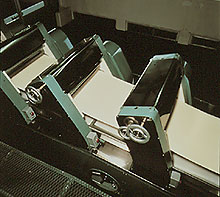
The dough is stretched using metal rollers.
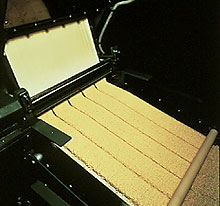
The
dough is sliced into noodles by a machine equipped with cutting blades.
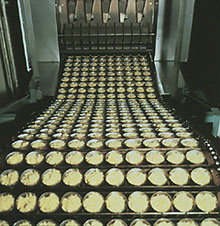
After being steamed at 100°C for five minutes, the noodles
are cut and placed in cup-sized portions.
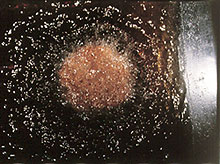
Noodles that are fried are cooked for one or two minutes in
order to remove the water.
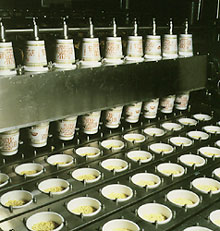
After cooling, the noodles are placed in styrofoam cups, and
flavoring is added.
Photos: Nissin Food Products Co.
|